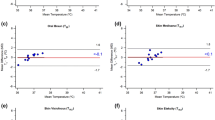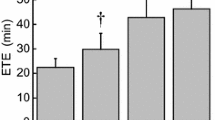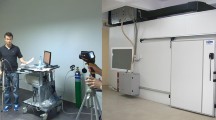Abstract
We investigated the validity of infrared tympanic temperature (IR-Tty) during exercise in the heat with variations in solar radiation. Eight healthy males completed stationary cycling trials at 70% peak oxygen uptake until exhaustion in an environmental chamber maintained at 30°C with 50% relative humidity. Three solar radiation conditions, 0, 250 and 500 W/m2, were tested using a ceiling-mounted solar simulator (metal-halide lamps) over a 3 × 2 m irradiated area. IR-Tty and rectal temperature (Tre) were similar before and during exercise in each trial (P > 0.05). Spearman’s rank correlation coefficient (rs) demonstrated very strong (250 W/m2, rs = 0.87) and strong (0 W/m2, rs = 0.73; 500 W/m2, rs = 0.78) correlations between IR-Tty and Tre in all trials (P < 0.001). A Bland-Altman plot showed that mean differences (SD; 95% limits of agreement; root mean square error) between IR-Tty and Tre were − 0.11°C (0.46; − 1.00 to 0.78°C; 0.43 ± 0.16°C) in 0 W/m2, − 0.13°C (0.32; − 0.77 to 0.50°C; 0.32 ± 0.10°C) in 250 W/m2 and − 0.03°C (0.60; − 1.21 to 1.14°C; 0.46 ± 0.27°C) in 500 W/m2. A positive correlation was found in 500 W/m2 (rs = 0.51; P < 0.001) but not in 250 W/m2 (rs = 0.04; P = 0.762) and 0 W/m2 (rs = 0.04; P = 0.732), indicating a greater elevation in IR-Tty than Tre in 500 W/m2. Percentage of target attainment within ± 0.3°C between IR-Tty and Tre was higher in 250 W/m2 (100 ± 0%) than 0 (93 ± 7%) and 500 (90 ± 10%; P < 0.05) W/m2. IR-Tty is acceptable for core temperature monitoring during exercise in the heat when solar radiation is ≤ 500 W/m2, and its accuracy increases when solar radiation is 250 W/m2 under our study conditions.



Similar content being viewed by others
References
Beeson EJG (1978) The CSI lamp as a source of radiation for solar simulation. Lighting Res Technol 10:164–166
Brinnel H, Cabanac M (1989) Tympanic temperature is a core temperature in humans. J Therm Biol 14:47–53
Casa DJ, Becker SM, Ganio MS, Brown CM, Yeargin SW, Roti MW, Siegler J, Blowers JA, Glaviano NR, Huggins RA, Armstrong LE, Maresh CM (2007) Validity of devices that assess body temperature during outdoor exercise in the heat. J Athl Train 42:333–342
Cohen J (1988) Statistical power analysis for the behavioral sciences, 2nd edn. Lawrence Erlbaum Associates, Hillsdale
Coso JD, Aguado-Jimenez R, Mora-Rodriguez R (2008) Infrared tympanic thermometry in a hot environment. Int J Sports Med 29:713–718. https://doi.org/10.1055/s-2007-989417
Ganio MS, Brown CM, Casa DJ, Becker SM, Yeargin SW, McDermott BP, Boots LM, Boyd PW, Armstrong LE, Maresh CM (2009) Validity and reliability of devices that assess body temperature during indoor exercise in the heat. J Athl Train 44:124–135. https://doi.org/10.4085/1062-6050-44.2.124
Guo J, Chen Y, Fan PWP, Lee MSH, Ong JX, Tan PL, Law LYL, Lee JKW, Seng KY (2018) Kalman filter models for the prediction of individualised thermal work strain In book: Kalman Filters - Theory for Advanced Applications. InTechOpen
Hansen RD, Amos D, Leake B (1996) Infrared tympanic temperature as a predictor of rectal temperature in warm and hot conditions. Aviat Space Environ Med 67:1048–1052
Hosokawa Y, Adams WM, Belval LN, Davis RJ, Huggins RA, Jardine JF, Katch RK, Stearns RL, Casa DJ (2016) Exertional heat illness incidence and on-site medical team preparedness in warm weather. Int J Biometeorol 62:1147–1153. https://doi.org/10.1007/s00484-018-1517-3
Landis JR, Koch GG (1977) The measurement of observer agreement for categorical data. Biometrics 33:159–174
Magee S (2010) Solar radiation—a cause of illness and cancer? Createspace, New York
Mathee A, Oba J, Rose A (2010) Climate change impacts on working people (the HOTHAPS initiative): findings of the South African pilot study. Glob Health Action 3:5612. https://doi.org/10.3402/gha.v3i0.5612
Maughan RJ, Leiper JB, Thompson J (1985) Rectal temperature after marathon running. Br J Sports Med 19:192–196
Morán-Navarro R, Courel-Ibáñez J, Martínez-Cava A, Conesa-Ros E, Sánchez-Pay A, Mora-Rodriguez R, Pallarés JG (2019) Validity of skin, oral and tympanic temperatures during exercise in the heat: effects of wind and sweat. Ann Biomed Eng 47:317–331. https://doi.org/10.1007/s10439-018-02115-x
Nassiri P, Monazzam MR, Golbabaei F, Dehghan SF, Rafieepour A, Mortezapour AR, Asghari M (2017) Application of universal thermal climate index (UTCI) for assessment of occupational heat stress in open-pit mines. Ind Health 55:437–443. https://doi.org/10.2486/indhealth.2017-0018
Otani H, Goto T, Goto H, Shirato M (2017) Time-of-day effects of exposure to solar radiation on thermoregulation during outdoor exercise in the heat. Chronobiol Int 34:1224–1238. https://doi.org/10.1080/07420528.2017.1358735
Otani H, Ishigaki T, Kaya M, Tsujita J, Hori S (2005) Comparison of tympanic membrane temperatures measured by contact and noncontact tympanic thermometers during prolonged exercise in the heat. Elsevier Ergonomics Book Series 3:21–24
Otani H, Kaya M, Tamaki A, Goto H, Maughan RJ (2019) Exposure to high solar radiation reduces self-regulated exercise intensity in the heat outdoors. Physiol Behav 199:191–199. https://doi.org/10.1016/j.physbeh.2018.11.029
Otani H, Kaya M, Tamaki A, Watson P, Maughan RJ (2018) Air velocity influences thermoregulation and endurance exercise capacity in the heat. Appl Physiol Nutr Metab 43:131–138. https://doi.org/10.1139/apnm-2017-0448
Sedgwick P (2013) Limit of agreement (bland-Altman method). BMJ 346:f1630. https://doi.https://doi.org/10.1136/bmj.f1630
Terndrup TE, Crofton DJ, Mortelliti AJ, Kelley R, Rajk J (1997) Estimation of contact tympanic membrane temperature with a noncontact infrared thermometer. Ann Emerg Med 30:171–175
Yeoh WK, Lee JKW, Lim HY, Gan CW, Liang W, Tan KK (2017) Re-visiting the tympanic membrane vicinity as core body temperature measurement site. PLoS One 12:e0174120. https://doi.org/10.1371/journal.pone.0174120
Zhao Y, Yi W, Chan APC, Wong DP (2018) Impacts of cooling intervention on the heat strain attenuation of construction workers. Int J Biometeorol 62:1625–1634. https://doi.org/10.1007/s00484-018-1562-y
Acknowledgements
The authors thank the participants who gave their time and effort to participate in the present study.
Funding
This study was funded by the Japan Society for the Promotion of Science KAKENHI (grant number 26870759).
Author information
Authors and Affiliations
Corresponding author
Ethics declarations
Conflict of interest
The authors declare that they have no conflict of interest.
Ethical approval
All procedures performed in studies involving human participants were in accordance with the ethical standards of the institutional and/or national research committee and with the 1964 Helsinki declaration and its later amendments or comparable ethical standards.
Rights and permissions
About this article
Cite this article
Otani, H., Kaya, M., Tamaki, A. et al. Solar radiation and the validity of infrared tympanic temperature during exercise in the heat. Int J Biometeorol 64, 39–45 (2020). https://doi.org/10.1007/s00484-019-01791-1
Received:
Revised:
Accepted:
Published:
Issue Date:
DOI: https://doi.org/10.1007/s00484-019-01791-1




